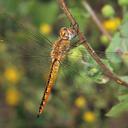United States and Canada
In flight, Wandering Gliders appear predominantly yellow or yellow/brown especially on the abdomen. They have a pale yellow face that becomes reddish in older males. The yellow to yellow-amber abdomen with a black dorsal stripe and pale face make this species distinctive.
This is the most widespread and cosmopolitan dragonfly in North America and perhaps worldwide. It is found nearly worldwide in tropical and temperate zones except Europe. Wandering Gliders are often abundant migratory dragonflies, commonly found far from water. A broad-winged skimmer with outstanding long range flight capabilities, it can even cross oceans. The broad hind wings allow it to glide efficiently, thus conserving energy.
Identification: Appears yellow to yellow-brown in flight, especially on the abdomen. Male with red eyes and yellow face. Thorax pale brownish-yellow, but generally less intensely colored than the abdomen. Abdomen yellow to yellow-brown (sometimes golden or orange in males) with black mid-dorsal stripe. Superior appendages long and black. Wings clear. Female much like male, but less intensely-colored.
The thorax is olivaceous brown and largely unmarked, with variable, subtle patterns of ochre, yellow, brown and reddish. The wings clear with brown apices in the males. The legs are pale basally, becoming black for most of their length. The stout, tapered abdomen is yellow with black stripes laterally on the swollen basal segments. There is a thin dark middorsal stripe that widens and becomes noticeably darker on segments 8-10. The pale caudal appendages are more or less bicolored in males, darkening in outer the half.
When perched shows a subtle, variable and beautiful range of colors which can be confusing to people who are only familiar with it on the wing. In these circumstances note the black mid-dorsal stripe and the wide, clear hindwing.
Size and Structure: 47-50 mm. This is a medium-large dragonlfy, clearly smaller than Common Green Darner and larger than Meadowhawks. Both sexes have distinctively broad hind wings. When perched, wings held out flat and stiffly to the sides.
When observed on the wing, the broad hindwing, stout, tapered and somewhat triangular abdomen is distinctive. Flies with wingbeats that are so shallow and quick that it appears that the wings are simply vibrating, which gives the impression that it is gliding. In flight the wings are held in a clear dihedral. The legs are held bunched up under the thorax, hanging down obviously in flight sometimes giving the impression that it is carrying something.
Similar species: Spot-winged Glider (P. hymenaea) is most similar, but is more brown than yellow and has a diagnostic dark basal spot in the hind wing. The Wandering Glider is a strong flier that moves back and forth constantly, which helps to distinguish it from other superficially similar skimmers.
Habits and Habitat: Perches by hanging vertically, often in the shade. Sometimes perches in groups on bushes or trees, often far from water.
Flies for long periods favoring open areas. It patrols fields, ponds, rooftops, parking lots and any other available open area, including medium-sized openings in forest. It flies typically flies at waist to head height but also flies high above treetops, They sometimes patrol a small area over and over and at other times are seen in direct high flight covering large distances.
The common name of this species may be the most appropriate of any of species.It often flies slowly and steadily into the wind, sometimes gliding on fixed wings for extended periods. Even when in powered flight, the movement of the wings is barely visible. As a result, flight appears smooth, graceful and steady, with occasional sudden quick detours to grab prey.
Wandering Gliders have a circumtropical distribution. It is regularly encountered by ocean freighters far from land and is a well-known migratory species. This species can drift with the wind, feeding on aerial plankton, until it encounters a rain pool in which it breeds, it has been called "...the world's most evolved dragonfly." It is generally more abundant in the fall when offspring from earlier in the spring migrate southward. They are often encountered in large mixed feeding swarms, along with saddlebag gliders (Tramea), where they prey upon small flying insects.
Males patrol territories of varying lengths 1-2 m above the water. Mating takes place in flight and lasts from 30 sec to an unusually long 5 min. Females lay eggs in temporary ponds or rainpools by tapping their abdomen to the water surface, alone or accompanied by the male. The larva can complete its cycle in as little as five weeks. It is not unusual, however to see females attempting to lay eggs on automobile roof tops, asphalt roads or other shiny structures that they mistake for water. They usually perch vertically on low stems and twigs, but sometimes they will perch horizontally with the abdomen depressed below the rest of the body. Eggs are deposited in ponds while flying in tandem straight over the water. Feeding swarms consist of both males and females in equal numbers over land and can occur at anytime from dawn to dusk. Early instars of the larvae are extremely tolerant to drought, living several months in dry mud.
Range: Found across North America in nearly all of the lower 48 US state, extreme southern Canada; southward throughout Central and South America, the Bahamas, West Indies, Hawaii and throughout the Eastern Hemisphere, except for Europe.
Source: Abbott, J.C. 2006-2010. OdonataCentral: An online resource for the distribution and identification of Odonata.
Reviewed by John C. Abbott
Revised by David A. Bell (9/30/2015).
